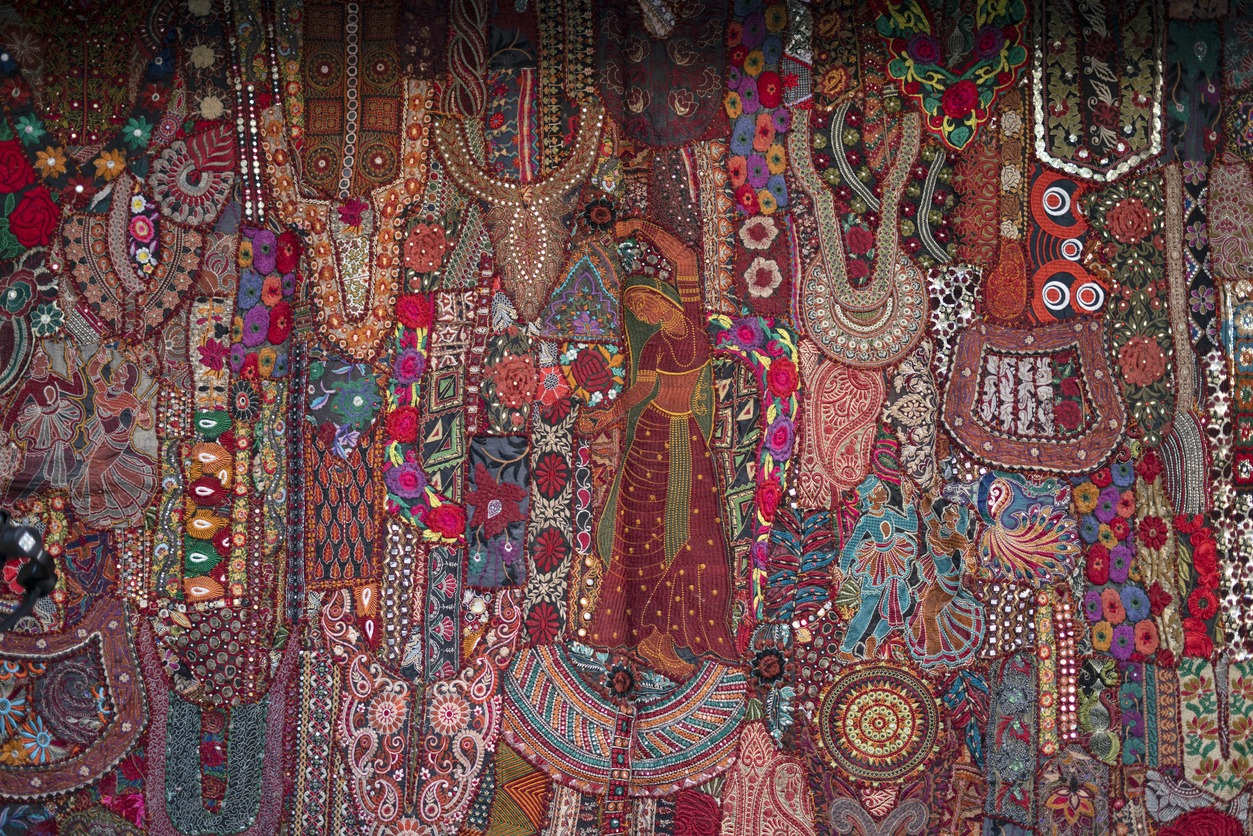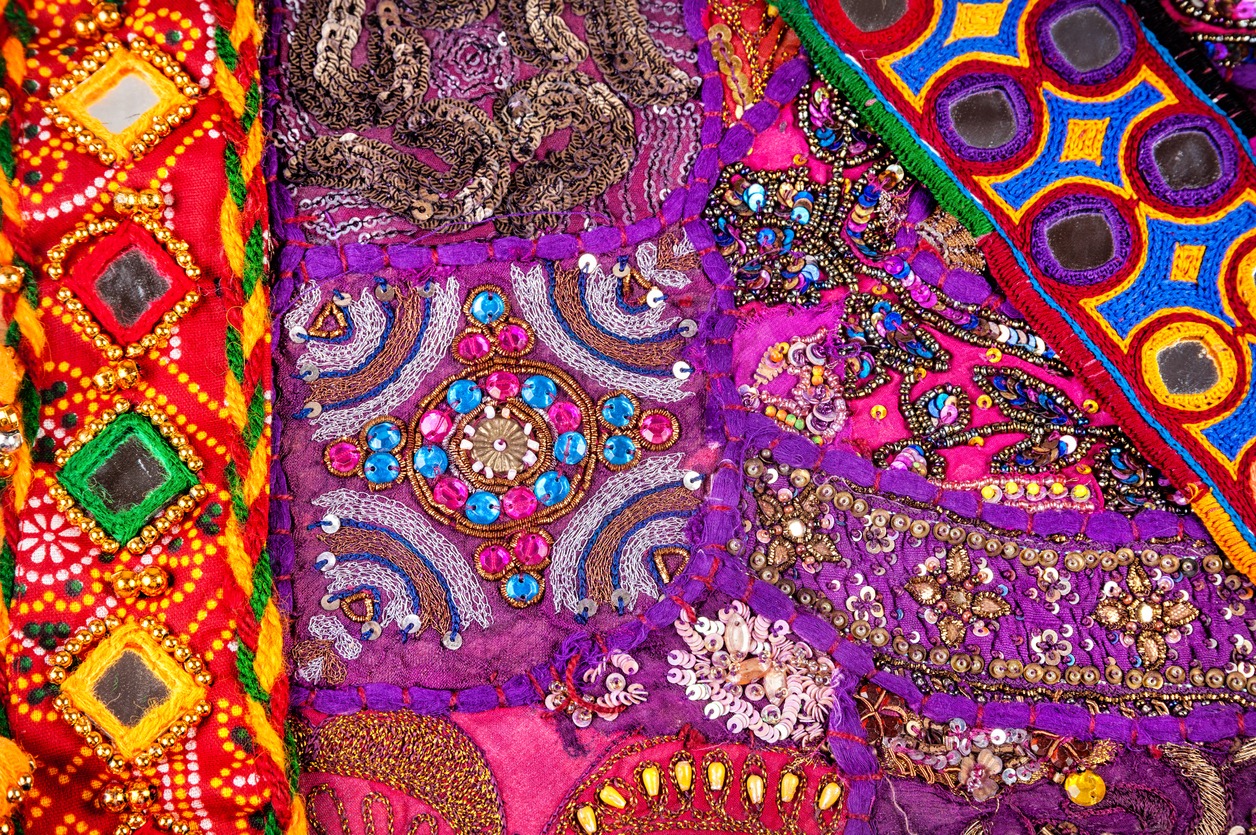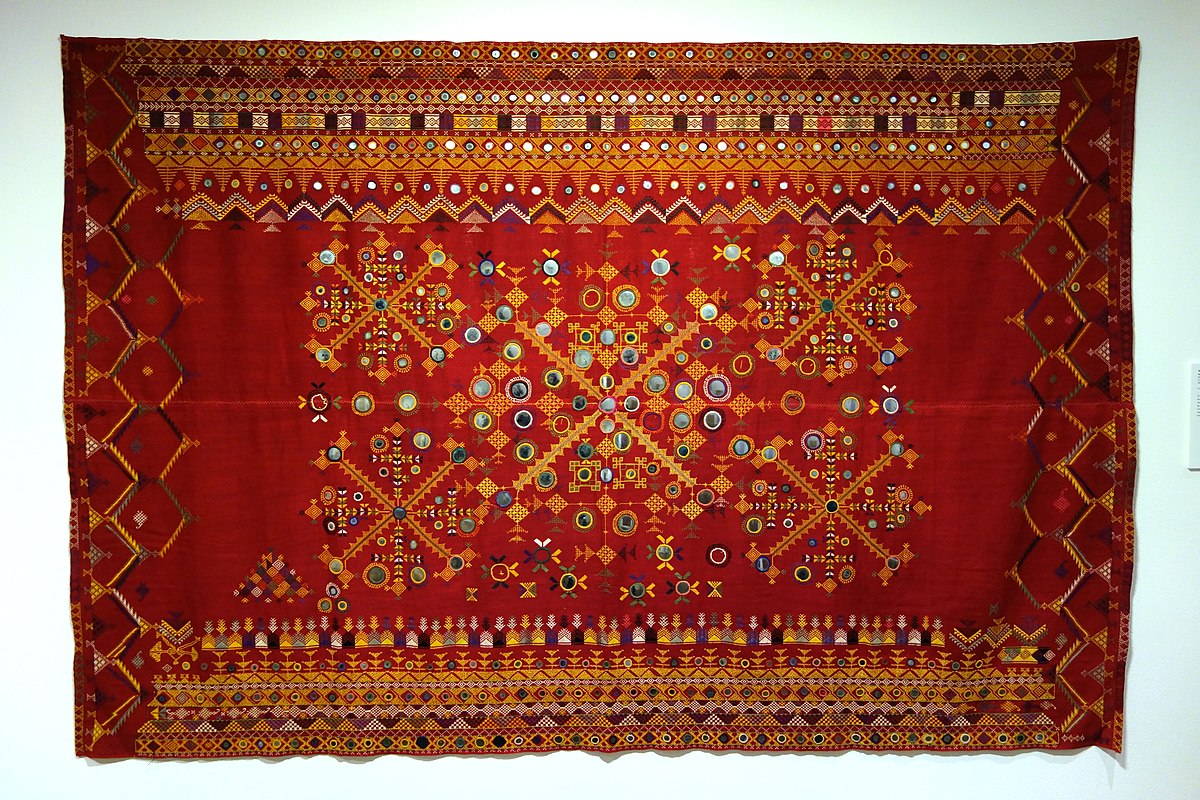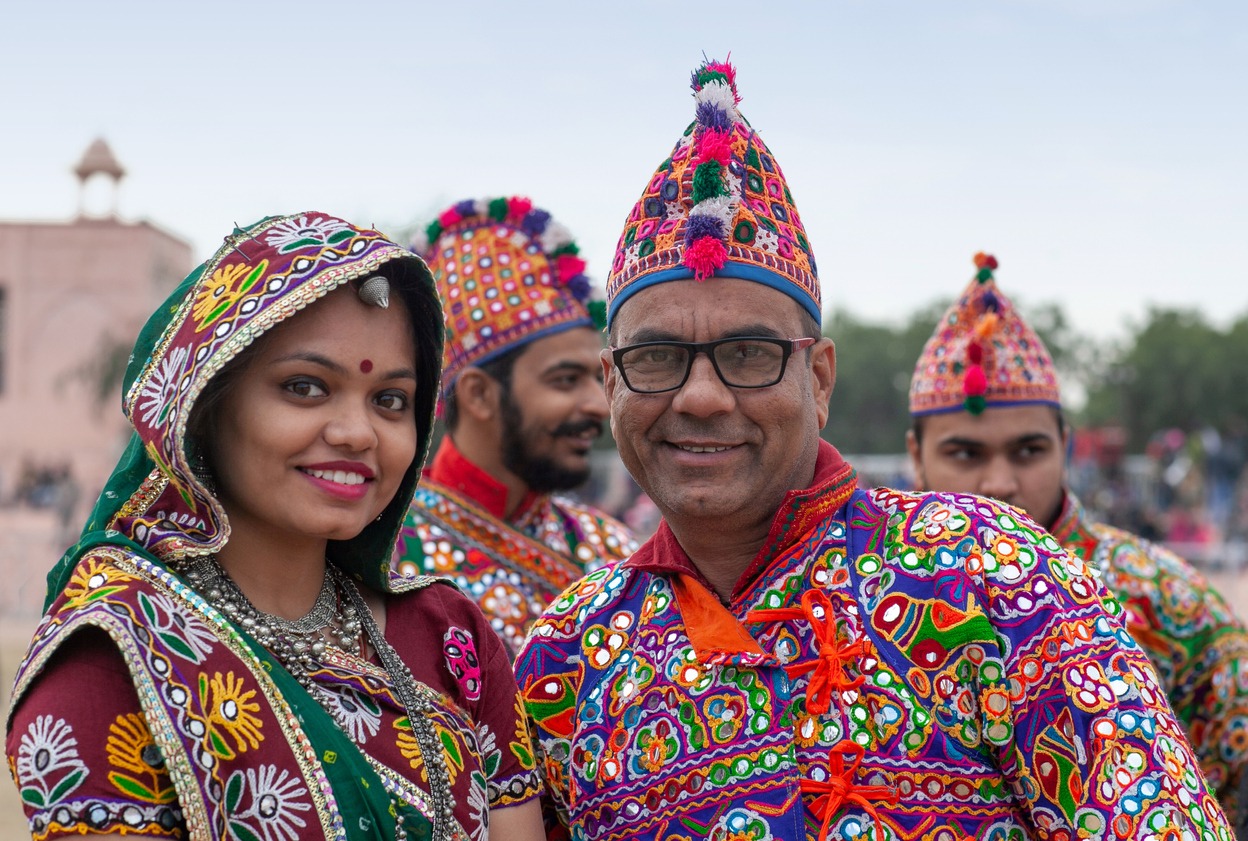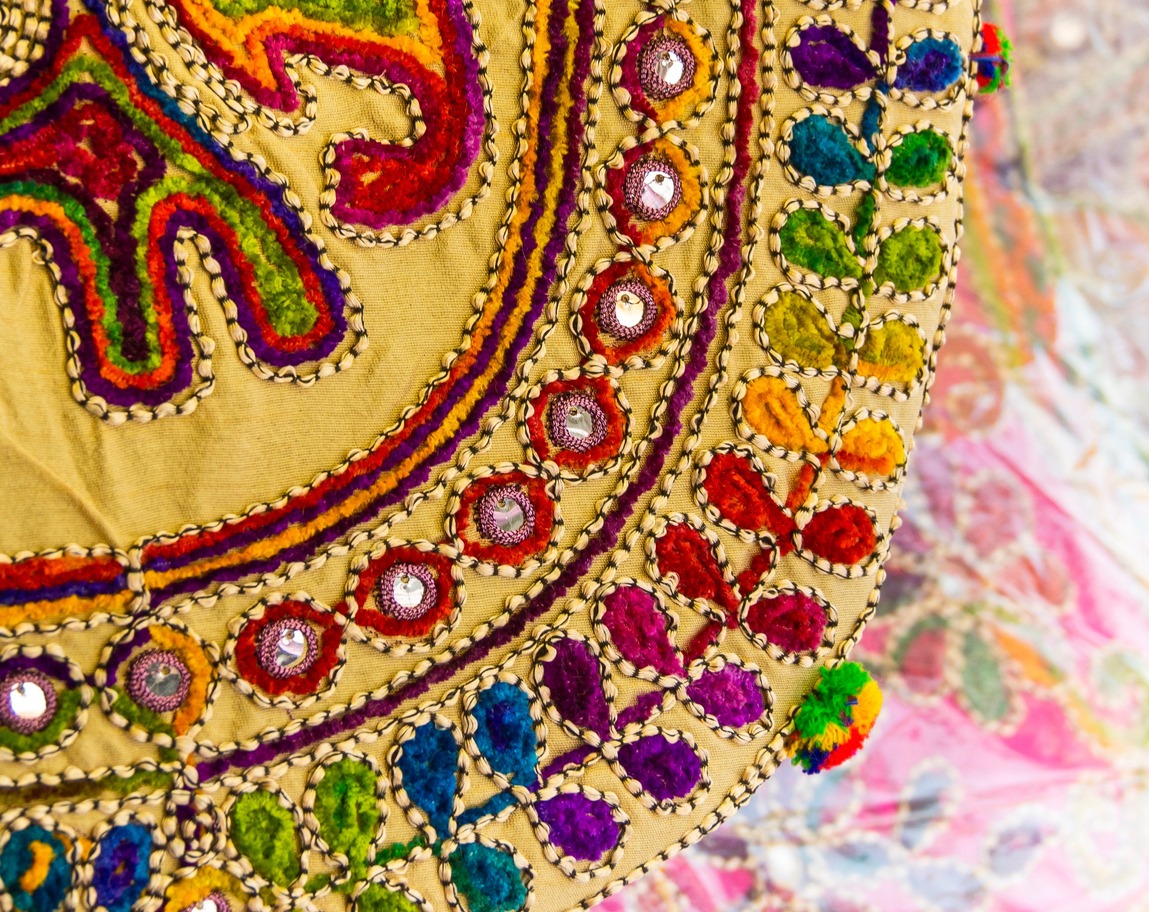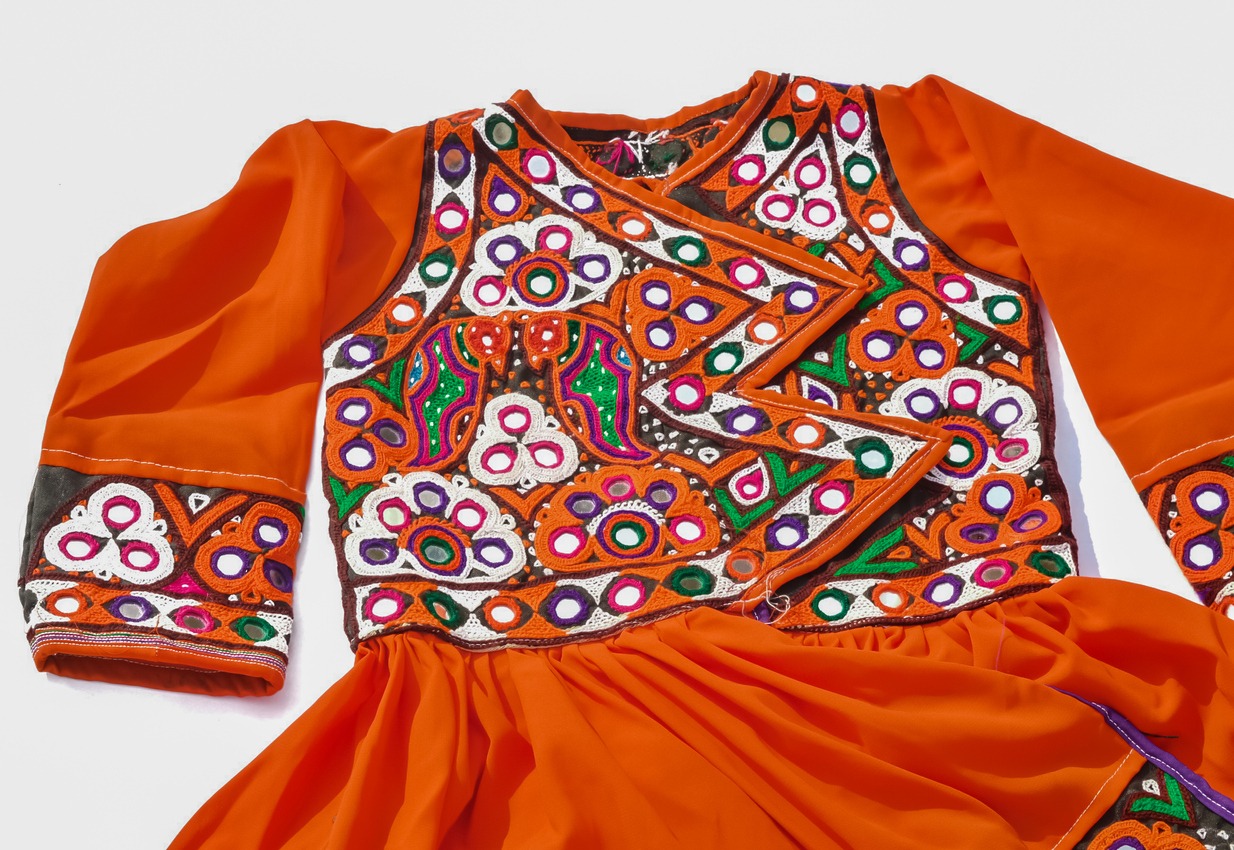Rajasthan’s mirror work, a dazzling component of Indian embroidery, offers a window into the rich tapestry of Indian cultural heritage. This unique art form, known locally as Shisha or Abhla Bharat embroidery, involves intricately embedding small pieces of mirrors into fabric. This traditional technique not only enhances the aesthetic appeal of textiles but also carries with it centuries of history and cultural significance, making it a fascinating subject for exploration.
The art of mirror work in Rajasthan is more than just a craft; it’s a storytelling medium that reflects the vibrant life and traditions of the region. Each piece of fabric adorned with these shimmering mirrors tells a story, whether it’s part of a garment, a home decor item, or a ceremonial object. In this blog post, we delve into the sparkling world of Rajasthan’s mirror work to understand how it illuminates the broader spectrum of Indian embroidery and its enduring legacy in the world of textiles.
Historical Background of Rajasthan’s Mirror Work
The story of Rajasthan’s mirror work, or Shisha embroidery, began several centuries ago, with its exact origins shrouded in the mists of history. While some historians trace its roots back to the Mughal era in the 17th century, others argue that it could be even older, possibly originating in the Middle East or Persian cultures. These regions were already skilled in the art of mirror inlay in textiles, and it’s believed that the craft made its way to Rajasthan through trade and cultural exchanges.
Once in Rajasthan, this technique was embraced and adapted by local artisans. It quickly became a significant part of Rajasthani culture, especially among the royal and noble families. The intricate work of embedding small pieces of mirror onto fabric was initially reserved for royal attire and ceremonial garb, signifying opulence and grandeur. The shimmering mirrors were not just decorative but were also believed to ward off evil spirits, making them a popular choice for important life events like weddings.
Cultural Integration and Artisan Communities
Over time, the art of mirror work seamlessly integrated into the broader tapestry of Rajasthani life. What began as a royal craft soon found its way into the everyday lives of the people. It began to adorn not only clothing but also household items, accessories, and more. This expansion of the craft beyond the royal courts into the lives of common people played a crucial role in its evolution.
Different communities within Rajasthan contributed their unique styles to the art of mirrorwork. Notably, nomadic tribes like the Banjaras were instrumental in spreading the craft throughout the region. Their distinctive approach to the craft, characterized by bold designs and vibrant colors, reflected their rich cultural heritage. Additionally, women in rural Rajasthan played a pivotal role in preserving and passing down these embroidery skills through generations, ensuring the survival and continuity of this traditional art form.
Geographical Influence and Symbolism
The geographical context of Rajasthan, characterized by its arid landscape and vibrant cultural life, also influenced the evolution of mirror work. In a land with a predominantly desert environment, the bright colors and reflective qualities of mirror embroidery offered a visual respite and symbolized life and energy. This use of mirrors in textile art became a unique way to counterbalance the starkness of the surroundings with vibrant, life-affirming art.
Rajasthan’s mirror work is not just an art form but a cultural narrative that has evolved over centuries. It is a testament to the region’s rich history, the adaptability of its people, and its unyielding spirit of creativity and innovation.
Techniques and Materials
The allure of Rajasthan’s mirror work lies in its intricate technique and the variety of materials used. This traditional craft combines the sparkle of mirrors with the texture of fabrics, brought together by skilled embroidery. Understanding these components is key to appreciating the complexity and beauty of this art form.
Key Materials
- Mirrors (Shisha): The centerpiece of this embroidery style is the small pieces of mirror, known as ‘Shisha.’ These are typically made from blown glass and carefully cut into various shapes like circles, squares, diamonds, or triangles. The size and shape of the mirrors vary depending on the design and the intended use of the embroidered piece.
- Fabrics: The base fabric for mirror work is crucial as it serves as the canvas for the embroidery. Commonly used fabrics include cotton, silk, and wool, selected for their durability and ability to hold the weight of the mirrors and stitches. The choice of fabric often depends on the region, with each area having its preferred type based on local availability and tradition.
- Threads: The threads used in the embroidery are typically cotton or silk. These are chosen for their strength and the ability to hold the mirrors securely in place. The color of the thread is often selected to contrast with the base fabric, highlighting the design and the mirrors.
Techniques of Embroidery
- Preparing the Mirror: The first step involves preparing the mirror pieces. This usually involves cutting the glass into the desired shapes and sizes. The edges are often filed down to prevent injury and to ensure they can be sewn onto the fabric smoothly.
- Creating the Design: The design is either traced or created freehand on the fabric. This serves as a guideline for placing the mirrors and executing the embroidery.
- Attaching the Mirrors: One of the most distinctive techniques in mirror work is attaching the mirrors to the fabric. This is typically done using one of two methods:
- Using a Cross-Stitch Method: This involves creating a cross-stitch over the mirror to hold it in place. The thread crosses over the face of the mirror, partially covering it and creating a decorative pattern.
- Using a Buttonhole Stitch: This method involves stitching around the edge of the mirror. The mirror is first encased in a fabric pouch, and then a buttonhole stitch is used around its edge to attach it securely to the fabric.
- Embroidery Around the Mirrors: Once the mirrors are attached, additional embroidery is often added around them to enhance the design. This can include various stitches like chain stitch, satin stitch, or running stitch and is used to create intricate patterns and add more color to the piece.
The Artisan’s Skill
The creation of mirror work is a time-intensive process that requires patience, precision, and skill. Artisans often learn these techniques through years of practice, usually passed down through generations. The quality of the work depends not only on the materials used but also on the artisan’s mastery of these traditional techniques.
Symbolism and Cultural Significance
Rajasthan’s mirror work is more than just a decorative art form; it is imbued with deep symbolism and cultural significance. Each aspect of this craft, from the materials used to the patterns created, carries meaning and reflects the rich heritage of the region.
Reflecting Beliefs and Traditions
- Protection and Good Fortune: The primary use of mirrors in this embroidery is rooted in ancient beliefs. Mirrors are thought to ward off evil spirits and bring good luck. This is why mirror work is commonly seen in clothing and accessories used during important life events like weddings and festivals.
- Symbol of Wealth and Status: Traditionally, the intricate and labor-intensive nature of mirror work made it a symbol of wealth and high social status. The more elaborate the embroidery, the higher the status it signified. This aspect is particularly evident in the garments and accessories of the Rajasthani royalty and nobility.
Designs That Tell Stories
- Motifs and Patterns: The motifs used in mirror work often have specific meanings. Common motifs include animals, birds, flowers, and geometric patterns, each symbolizing different aspects of life and nature. For instance, a peacock might symbolize beauty and grace, while a flower might represent fertility or the beauty of nature.
- Colors with Meanings: The colors used in the embroidery also hold significance. Red might symbolize love and strength, while green could represent fertility and renewal. The choice of colors is often influenced by local customs, religious beliefs, and the occasion for which the item is made.
A Canvas of Cultural Identity
- Cultural Reflection: Mirror work is a reflection of the diverse culture of Rajasthan. It showcases the artistic sensibilities of various communities within the region and serves as a canvas for expressing their cultural identity.
- Storytelling through Craft: Each piece of mirror work tells a story, whether it’s about the artisan’s own experiences, local legends, or the everyday life of the community. This storytelling aspect makes each piece unique and a bearer of the rich oral traditions of Rajasthan.
In essence, the mirror work of Rajasthan is a vibrant tapestry woven with threads of tradition, culture, and symbolism. It’s a living art form that continues to evolve while maintaining its deep-rooted meanings and significance. Through its intricate patterns and shimmering mirrors, it offers a glimpse into the soul of Rajasthan, its people, and its enduring traditions.
Contemporary Status and Innovations
Rajasthan’s mirror work, while steeped in tradition, has not remained untouched by the waves of modernity and changing global trends. Today, this ancient craft faces the dual challenge of preserving its traditional essence while evolving to meet contemporary tastes and demands.
Current State of Mirror Work
In some parts of Rajasthan, traditional mirror work continues to thrive, with artisans adhering closely to ancestral methods. However, in other areas, the craft faces challenges due to the rising costs of materials, competition from mass-produced items, and a dwindling number of skilled artisans.
Internationally, there’s a growing appreciation for handcrafted, ethically produced items. Rajasthan’s mirror work has garnered interest in global fashion and interior design, providing new opportunities for artisans.
Innovations and Modern Adaptations
Younger artisans and designers are experimenting with modern designs, incorporating mirror work into Western-style clothing, accessories, and home decor. This fusion approach helps attract a broader, more diverse audience. Innovations in techniques and the use of alternative materials are also emerging.
Some artisans are experimenting with lighter, more durable materials for mirrors and eco-friendly fabrics, expanding the possibilities of traditional mirror work. The digital era has opened new markets for artisans. Online platforms and social media are increasingly used to showcase and sell mirror work, reaching customers beyond the geographical confines of Rajasthan.
Challenges and Efforts to Preserve the Tradition
NGOs, government bodies, and cultural organizations are stepping in to preserve this ancient art. Initiatives include training programs for new artisans, financial support, and efforts to promote mirror work in national and international markets.
The key challenge facing Rajasthan’s mirror work today is balancing commercial success with the preservation of its traditional identity. While innovation is necessary for survival, it’s equally important to ensure that the essence of this ancient craft is not lost in the process.
The contemporary status of Rajasthan’s mirror work is a testament to its resilience and adaptability. As it navigates through the challenges of modern times, the craft continues to evolve, finding new expressions and admirers. By embracing innovation while honoring tradition, mirror work can continue to be a vibrant and relevant part of Rajasthan’s cultural legacy.
Global Influence and Fashion Integration
Rajasthan’s mirror work, once confined to the boundaries of regional tradition, has now found its way onto the global stage. This unique form of embroidery has caught the eye of the international fashion and design industry, influencing styles and trends far beyond its origins.
Fashion Industry Integration
Renowned designers from around the world have incorporated Rajasthan’s mirror work into their collections, showcasing them on international runways. This fusion has brought a traditional Indian art form into the realm of high fashion, creating a blend of ethnic and modern aesthetics.
Beyond the runways, mirror work has also made its way into mainstream retail. Global fashion brands have adopted elements of this embroidery in their clothing lines, accessories, and home decor items, making it accessible to a broader audience.
Design Collaborations and Cross-Cultural Exchanges
There’s a growing trend of international designers collaborating directly with Rajasthani artisans. These collaborations often result in unique, cross-cultural creations that honor the traditional craft while infusing contemporary elements.
Exchange programs and workshops have been established to foster a deeper understanding and appreciation of Rajasthan’s mirror work among global designers and artists. These initiatives promote cultural exchange and provide new perspectives for both local artisans and their international counterparts.
Challenges and Opportunities
As mirror work gains global popularity, ensuring the authenticity and ethical production of these items becomes crucial. There’s a risk of the craft losing its traditional essence in the mass production process. The global interest in mirror work presents significant economic opportunities for local artisans. It opens up new markets and can lead to increased income and recognition for their skills.
Impact on Local Communities
The global demand for mirror work can play a role in empowering local artisan communities, especially women artisans. It provides them with sustainable livelihoods and helps in preserving this age-old craft. As Rajasthan’s mirror work garners international acclaim, it instills a sense of pride among the local communities. It reinforces the importance of preserving their cultural heritage and passing it on to future generations.
The journey of Rajasthan’s mirror work from local craft to global trendsetter is a remarkable story of cultural endurance and adaptability. As this traditional art form continues to integrate with global fashion, it not only enriches the world’s cultural tapestry but also brings new opportunities and challenges to the artisans who have been its custodians for generations.
Conclusion
Rajasthan’s mirror work is a fascinating blend of history, art, and culture. This traditional craft, originating from the heart of India, has journeyed far beyond its geographical roots, capturing the imagination of people around the world. Its evolution from a regional handicraft to an element of global fashion and design speaks volumes about its versatility and enduring appeal.
As we’ve seen, the future of this art form is a delicate balance between innovation and the preservation of its rich heritage. By appreciating and supporting this craft, we not only celebrate a beautiful art form but also contribute to sustaining the communities that have kept this tradition alive for centuries. Rajasthan’s mirror work is not just an embroidery technique but a vibrant story that reflects the spirit and artistic legacy of its people over time.
